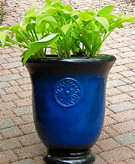A bothersome pest of hostas is the fungus Sclerotium rolfsii, commonly called Southern Blight because it is a more common problem in the southern part of the USA where it is hotter. But it can still be a problem in northern gardens here in Michigan. This fungus attacks the hosta leaf stalks (the petioles) and causes the stalk and leaf to fall over and go brown and mushy. There will also be a white fuzzy looking mass of the fungal strands around the base of the affected stalks and some small, round, white to orange-brown seed-like structures in and around the fuzz. These round things spread the fungus, so be careful to remove them and all affected stalks from the clump if you find an infection. As the infection continues, all the stalks and leaves of your hosta clump can fall over.
This fungal infection can be successfully treated with application of a garden antifungal product that specifically mentions "Southern Blight" on the label. One such product that I have found locally in central Michigan is Bio-Advanced brand Disease Control for Roses, Flowers, and Shrubs. I have applied this diluted product as either a drench onto the crown of hosta clumps (especially early in the season before the leaves are fully unfurled, as a preventative measure), or as a spray in a small tank sprayer with a wand to spray down into the petioles and at the crown later in the season when the clumps are leafed out.
As a preventative measure, when I get potted hosta plants from vendors in southern states, I remove all the potting mix from around the roots, throw the soil in the trash (not compost pile), rinse the roots well with water, and dip them into a solution of the antifungal product. Alternatively, when I repot the hosta or plant it in the garden, I give the new soil and crown a drench of a cup or two of the antifungal product diluted per the manufacturer instructions. Many southern nurseries will just send bare-root hostas and avoid the soil issues of potted plants.
